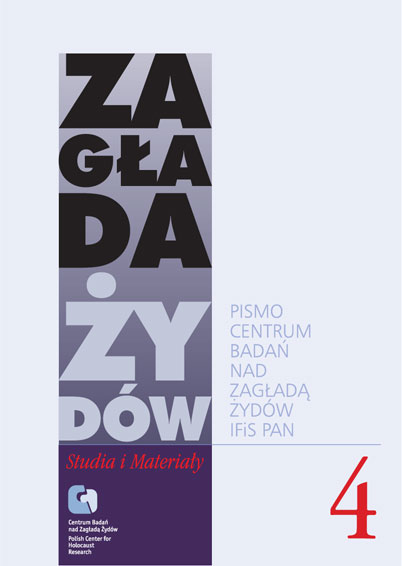”Arbeit macht frei” – several remarks on the genesis and the ideological background of the slogan on the basis of Wolfgang Brückner book "Arbeit macht frei: Herkunft und Hintergrund der KZ –Devise"
Zagłada Żydów. Studia i Materiały, No. 4 (2008), Pages: 499-510
Submission Date: 2020-10-15Publication Date: 2008-11-02
 https://doi.org/10.32927/ZZSiM.285
https://doi.org/10.32927/ZZSiM.285
Abstract
The following paper is based primarly on the extensive study conducted by Wolfgang Brückner in his book Arbeit macht frei: Herkunft und Hintergrund der KZ –Devise. The article aims to present the origin, social context and ideological background of the motto “Arbeit macht frei” and other related texts placed above the entrances to some of the nazi concentration camps. The author raises the question, to what extent was the act of placing of such a motto in a KZ a mere sign of cynism or a conscious demonstration of ideological conviction of the SS-members, internalized in the process of bringing up and socialization in a specific environment.
Keywords
“Arbeit macht frei” , Rudolf Höss , forced labor , concentration camps
License
Copyright (c) 2008 Author & "Holocaust Studies and Materials"

This work is licensed under a Creative Commons Attribution 4.0 International License.
https://creativecommons.org/licenses/by/4.0
Similar Articles
- Anna Ziółkowska, Camp Medicine. On Jewish Workers’ Illnesses, Suffering and Death in the Forced Labor Camps in Poznań (1941–1943) , Zagłada Żydów. Studia i Materiały: No. 8 (2012)
- Mordechay Giloh, Distinct Profiles and Characteristics of Jewish and non-Jewish Concentration Camp Survivors in Sweden , Zagłada Żydów. Studia i Materiały: No. 8 (2012)
- Heléna Huhák, András Szécsényi, Cavalcade of Interpretations: The Kasztner train Through the Self-narratives of the Fugitives , Zagłada Żydów. Studia i Materiały: No. 18 (2022)
- Zofia Wóycicka, “At the Limit of a Certain Morality”: Debates on the Trials of Functionary Prisoners in Poland 1945–1950 , Zagłada Żydów. Studia i Materiały: No. 3 (2007)
- Justyna Majewska, “The Witnesses Testified as Follows…” Records of Interrogations of Polish Railways Employees who Worked at the Stations near the Operation Reinhardt Camps , Zagłada Żydów. Studia i Materiały: No. 13 (2017)
- Piotr Filipkowski, Piotr M.A. Cywiński, Auschwitz. Monografia Człowieka [Piotr Filipkowski] , Zagłada Żydów. Studia i Materiały: No. 17 (2021)
- Johannes Breit, Lukas Meissel, Playing with Holocaust symbols. The video game franchise ‘Wolfenstein’ as a case study for digital Holocaust representations , Zagłada Żydów. Studia i Materiały: No. 17 (2021)
- Nawojka Cieślińska-Lobkowicz, The new Holocaust Museum in Amsterdam , Zagłada Żydów. Studia i Materiały: No. 20 (2024)
- Piotr Filipkowski, Review: Więźniowie KL Lublin 1941–1944, red. Tomasz Kranz, Wojciech Lenarczyk, Lublin: Państwowe Muzeum na Majdanku, 2021, 599 s. , Zagłada Żydów. Studia i Materiały: No. 18 (2022)
- Daniel Logemann, European Dimension of the Holocaust in Books by German Historians or How to Write About the Anti-Jewish Violence Not Perpetrated by Germans , Zagłada Żydów. Studia i Materiały: No. 14 (2018)
You may also start an advanced similarity search for this article.
 English
English
 Język Polski
Język Polski



 https://orcid.org/0000-0002-0102-7219
https://orcid.org/0000-0002-0102-7219





